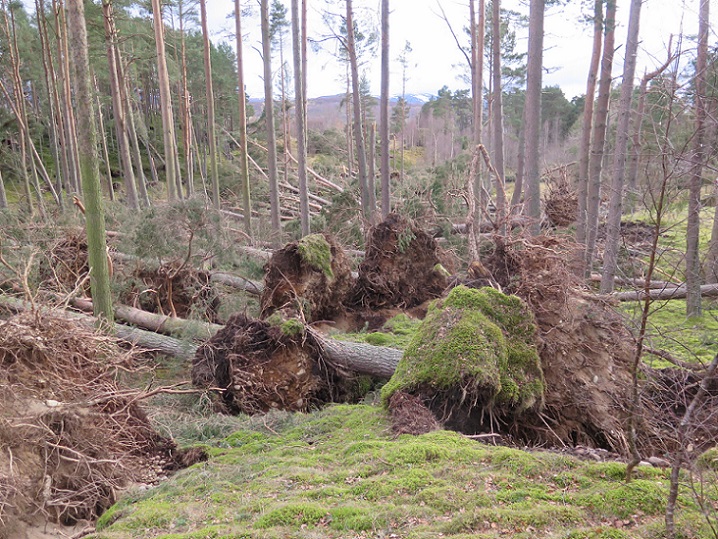
After Storm Arwen, Forestry and Land Scotland (FLS) issued a news release in December titled “A shot across the boughs” (see here) in which it stated that “we will be dealing with the impact of November’s storm for months, and even years, to come, it is a timely reminder that we are right to pursue forest adaptation.”
FLS estimated that Storm Arwen blew down about 8 million trees. That is over a third of the 22 million trees planted in Scotland in 2019-20 (see here). There have been at least five other damaging storms in the last six months and FLS has been issuing warnings about the “need” to fell mature trees on exposed sites in upland areas before they get blown over. We are in a position where Scotland risks seeing more trees blown over in the next decade than will be planted.
On top of that there are the trees that are being felled because of disease – no less than 41 of FLS’ plantations are currently being chopped down (see here). Far from helping to mitigate the impacts of climate change, the dominant model of forestry as it has been practised in Scotland for the last 100 years faces a terminal crisis.
While global warming seems to be driving increasingly intense storms, as we have experienced this winter, the underlying problem is less wind than the way the forest industry has planted and is still planting trees. I will illustrate the issues by what I saw in the course of a day on Speyside last Sunday.
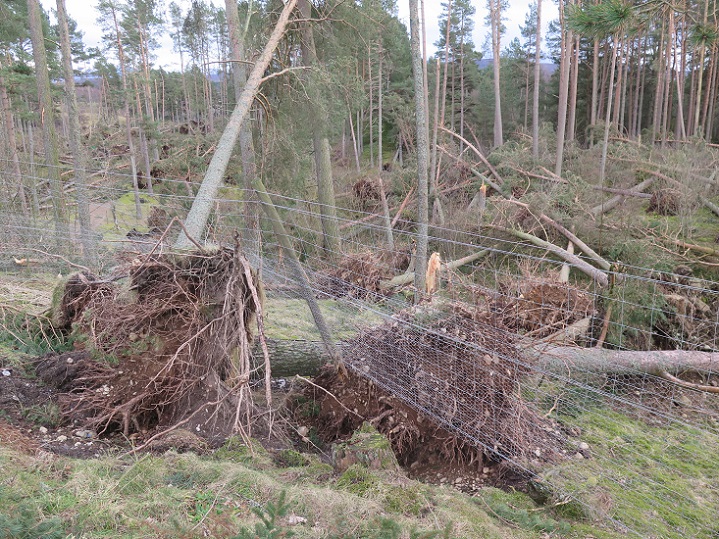
Setting out from Newtonmore with Dave Morris and Anne MacIntyre for a walk on the Speyside part of the Kinrara estate we passed the Highland Folk Park where a significant part of the Scots pine plantation had blown over. The plantation may or many not have been intended for commercial purposes but it was designed according to standard forestry practices.
Under the received forestry model, trees are planted close together at the same time to promote rapid growth. As a consequence they have shallow roots and develop into monolithic blocks which become increasingly exposed to the wind as they grow older. The problem is then made worse as grazing pressure, both inside the deer fencing and out, prevents any younger trees from regenerating naturally around it. There is thus nothing to shelter the shallow rooted trees from the wind. The consequences are predictable. Once the trees reach a certain age, all it needs is a strong enough wind comes from the right direction and many will topple.
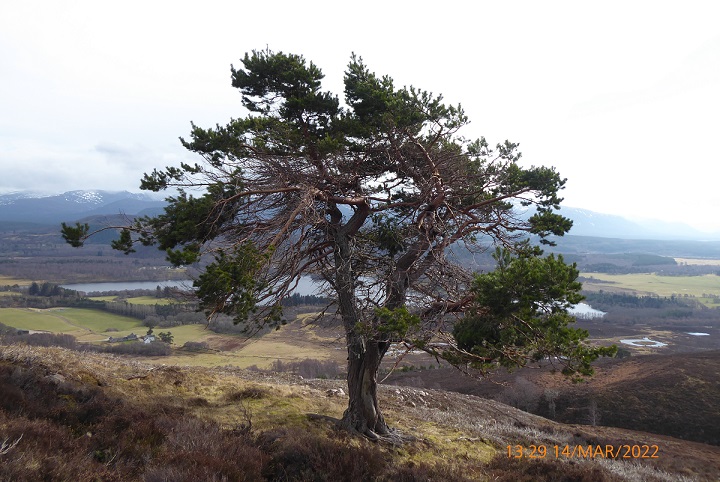
The contrast between what we saw in Newtonmore and what we saw on the hillside overlooking Loch Alvie at Kinrara was striking. There, in a far more exposed position, not a single one of the scattered pines had blown over, though there were plenty of signs of the storm passing. Had this hillside not been overgrazed and burned, it would have been covered in younger trees making these older pines even more resistant to wind throw.
While FLS announced in its new release that it is “adapting forests by planting a greater mix of species at different times to create a patchwork of forests of uneven height – actions that will help to dissipate wind gusts and offer greater protection for the forest”, it has recently been planting trees in lines, close together and all in one go in the Glenmore Forest Park as I showed in my last post (see here).
The even greater folly of planting trees in plastic shelters was illustrated by what we saw along the newly dualled section of A9 south of Aviemore between Kincraig and Kinrara:
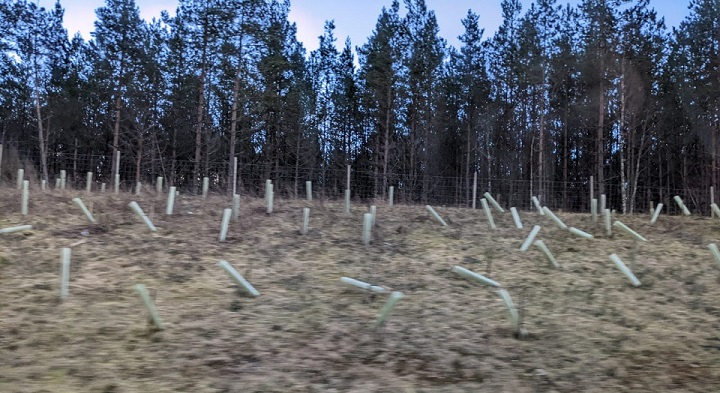
Normally saplings just bend to the wind but put a shelter round them and many will just blow over even when attached to a wooden stake.
How much public money has Transport Scotland wasted here? And how long will it take them to clear up the battered tubes that are shedding plastic into the natural environment?
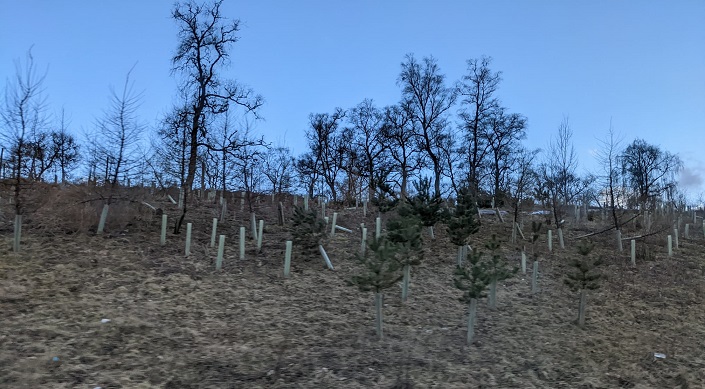
We did not get a photo of the worst hit section, near the start of the dual carriageway heading north, where almost every tree in a tube had been blown over. While this photo does not at first sight look as bad, note how trees that are perhaps 12 foot tall but still clad in their plastic tubes have blown over. Note too how the larger older trees, most of which probably developed through natural regeneration and preceded the construction of the dual carriageway, are still standing.
What needs to change
Wind throw is not a new problem, it has affected plantation forestry as practised in Scotland for many years and there have been systems to assess risk since the 1960s (see here). But such is the level of subsidy for planting trees and the power of the forest industry that it has carried on regardless until now.
FLS now appears to have recognised the need for change and stated in their news release “that forest adaptation has to be a focus for the sector in the coming years if damage from storms like Arwen is to be minimised”. The changes they are proposing, however, are quite limited:
“Modern, adaptive techniques include planting a greater mix of species to create a patchwork, which will help to dissipate wind gusts and offer greater protection for the forest.
Planting trees at different stages of a forest’s development will create variation in the heights of trees within a forest, which will also help to dissipate gusts of wind.”
FLS’ focus is still on planting trees rather than allowing more resilient forests to develop through natural regeneration.
Instead of planting large monolithic blocks of trees all in one go, it looks as if FLS is moving towards planting smaller blocks over the course of several years. How much that will reduce wind throw is unclear.
The regulator and disburser of grants, Scottish Forestry, appears even more conservative. The guidance they have put out following the storms (see here) is all about getting cash out to landowners and re-stocking areas that have been blown over as quickly as possible:
“Felling permission for wind blow will normally include a condition to restock. We expect your restocking proposal to include the entire felled area. Consideration should be given to the resilience of the future stand in order to take account of wind events and other climate change related risks. Restocking proposals may include open ground and a change to the species being planted.”
Expecting landowners to give consideration to wind throw is meaningless and there is not a mention of natural regeneration. In response to climate change Scottish Forestry just appears to be re-packaging current industrial practices and perpetuating the current disastrous system.
There is another way, however, which is broadly termed “continuous cover forestry” (see here). This is commonly practised in the rest of Europe, avoids all clear fell – which creates new forest edges exposed to the wind – maintains the woodland canopy and uses natural regeneration rather than planting to enable new trees to take root. The forest is then managed through the selective felling to influence how the trees grow and what species grows where and how. It puts the skills back into forestry and would create local employment. But its far too slow and concerned about people and the natural environment to be contemplated voluntary by our extractive forestry system
Our National Parks could and should be taking a lead on promoting continuous cover forestry (outside of areas of forest that should be left to nature) and forcing Scottish Forestry and FLS to change, rather than accepting what they do.

Under the land grab now underway in Scotland, as corporate interests like BrewDog, Standard Life and Aviva buy up huge tracts of land, for carbon offsetting purposes, there appears to be no chance that forestry practice will move in the required direction. These companies, and their investment backers, seem to be fixed on the standard model: put up mile upon mile of deer fencing across our mountains and moorlands and plant as many trees as possible within the fence, as quickly as possible. Then wait for the asset value of the land and planted trees to skyrocket until it is time to reap the profit and move on to the next cash cow. All this is greatly helped by the existing forestry grants available from the Scottish Government to encourage our new lairds to engage in a 21st Century version of the Highland Clearances. New rules are required, as a matter of urgency, to prohibit the use of deer fencing in these forestry operations. A fraction of the public money currently being wasted on these fences would be far better spent on employing more stalkers to cull the deer so that the natural regeneration of existing woodland , along with new planting over long periods of time, in appropriate locations, becomes the cornerstone of Scottish forestry policy. Only then will our forests be resilient to wind and disease and able to deliver the essential requirements for climate change mitigation, biodiversity recovery, flood protection and the supply of timber and other products.
What struck me was the localised nature of the wind damage. The area E and SE of Drumguish was apparently little damaged despite being monocultured plantations. As far I’ve seen Feshie was little affected neither naturally regenerated areas nor plantations.
Quite a lot of the damage in Badenoch was on E facing slopes. Sturdy gnarly pines along with birches were downed on Balavil.
Some gusts of the last of those named storms on Sunday 30 th January were at Kingussie particularly ferocious. There was what seemed a very different degree of turbulence from the “normal” storm.
Perhaps I’m mistaken but Ardverikie seems over the years to have an enlightened approach with its 70 year rotation policy.
Is it not the case that we need “industrial” forestry for building and for a chemical base for an alternative to oil based plastics?
Most usefully we could do with local foresters who gain insight from living and working alongside the trees.
The reason trees in plantations are planted so close, as I understand it, is to ensure they cast side branches early while trunk diameter continues to expand through active growth at the top in the light. This permits the development of sizeable lengths of knot free wood for construction. The problem I think is not that their roots are shallow, all trees I think have largely shallow root systems – but that the span of the anchoring root base is limited through competition. As the tree grows, leverage on this restricted root space increases and hence vulnerability to windthrow. Once outer more wind resistant trees are blown over the inner more vulnerable trees are exposed and the windthrow spreads. Trees are also planted at a density to maximise timber yield – until the wind comes.
Excellent and timely look at the wind throw issue, add to that disease susceptibility, increased fire risk and wetter winters causing waterlogging that helps to destabilize tree roots it’s about time this issue had wider consideration and a review of the way we do forestry. I’m hard pressed to find another country that operates forestry in quite the way we do all to produce pretty low quality softwood.